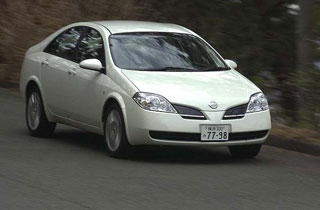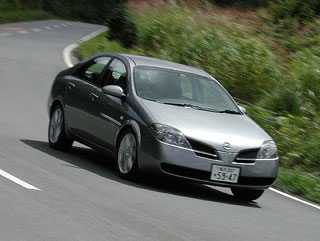Test drive Nissan Primera sedan since 2002 sedan
Nissan Primera 2.0 CVT

Theoretically, the advantages of the variator over the traditional stepped transmission are obvious. Smooth regulation of a gear ratio promises and fuel savings, and improved dynamics, and a more comfortable ride.
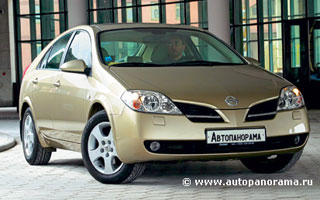 But, as you know, from the theoretical scheme to the real design, a long path requiring tests, refinement, overcoming difficulties and contradictions, which in theory were simply not taken into account. And if you add here the power of a human habit that affects the perception of a new, unusual design, you can easily understand why many ideas that are magnificent at first glance still remain ideas. But the variator, it seems, found his way to the masses, and to find out with which trump cards he was going to play against mechanics and machine gun, we took the Nissan Primera test with a stray transmission.
But, as you know, from the theoretical scheme to the real design, a long path requiring tests, refinement, overcoming difficulties and contradictions, which in theory were simply not taken into account. And if you add here the power of a human habit that affects the perception of a new, unusual design, you can easily understand why many ideas that are magnificent at first glance still remain ideas. But the variator, it seems, found his way to the masses, and to find out with which trump cards he was going to play against mechanics and machine gun, we took the Nissan Primera test with a stray transmission. Much in common
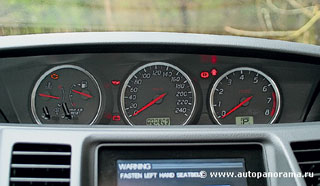 The car with a car with a variator is practically no different from the passenger compartment with a traditional automatic gearbox. The same selector with the usual P, R, N, D and mode for difficult conditions of movement L. Only a red button turned off the transmission during towing was added. And for those who sometimes like to independently switch the programs, there are six fixed positions that imitate the usual step -by -stroke KP. In this case, it is possible to switch the gears in this case as in the manual mode of the machine, that is, by moving the lever forward (increased transmission) or backward (lowering the transmission) along a special slot. To begin with, we transfer the lever to the Drive position and try to get out of the Moscow Center clogged with cars. In the urban mode of movement, no special difference between an automatic box and a variator is not noticeable.
The car with a car with a variator is practically no different from the passenger compartment with a traditional automatic gearbox. The same selector with the usual P, R, N, D and mode for difficult conditions of movement L. Only a red button turned off the transmission during towing was added. And for those who sometimes like to independently switch the programs, there are six fixed positions that imitate the usual step -by -stroke KP. In this case, it is possible to switch the gears in this case as in the manual mode of the machine, that is, by moving the lever forward (increased transmission) or backward (lowering the transmission) along a special slot. To begin with, we transfer the lever to the Drive position and try to get out of the Moscow Center clogged with cars. In the urban mode of movement, no special difference between an automatic box and a variator is not noticeable.  With a relatively calm rhythm of movement, the motor operates in the range of about 1500-2000 rpm, it is practically inaudible, of course, no switching occurs, but modern automatic boxes in such a calm rhythm also act smoothly and imperceptibly for the driver. Supporting the speed of a traffic stream with a variator is no more difficult than with an automaton, the machine adequately reacts to the work of the gas pedal, without annoying the driver with delays or unexpected independent actions. Perhaps in the city between the variator and the automatic parity: which and the other are quite convenient to use.
With a relatively calm rhythm of movement, the motor operates in the range of about 1500-2000 rpm, it is practically inaudible, of course, no switching occurs, but modern automatic boxes in such a calm rhythm also act smoothly and imperceptibly for the driver. Supporting the speed of a traffic stream with a variator is no more difficult than with an automaton, the machine adequately reacts to the work of the gas pedal, without annoying the driver with delays or unexpected independent actions. Perhaps in the city between the variator and the automatic parity: which and the other are quite convenient to use. But there is a difference
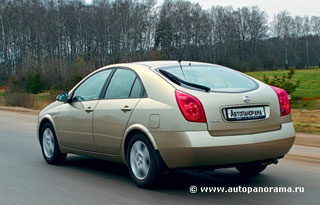 On the suburban roads between the variator and the automatic box, differences showed. First of all, the difference is noticeable, of course, on acceleration. With a completely pressed gas pedal, the engine operates at 5000 rpm, and the car is evenly accelerated. This is somewhat unusual, especially for drivers who determine the intensity of acceleration and speed, as they say, by ear. The variator deprives such drivers of the usual landmarks, and the speed has to be controlled by a speedometer. This, of course, is unusual, but you can adapt to the features of the variator machine quite quickly. But even when accelerating with full gas, no jerks, with a sharp acceleration on the move, the car does not work out, as it would be with an automaton, the engine is just flying to 5000 and acceleration begins. Truth,
On the suburban roads between the variator and the automatic box, differences showed. First of all, the difference is noticeable, of course, on acceleration. With a completely pressed gas pedal, the engine operates at 5000 rpm, and the car is evenly accelerated. This is somewhat unusual, especially for drivers who determine the intensity of acceleration and speed, as they say, by ear. The variator deprives such drivers of the usual landmarks, and the speed has to be controlled by a speedometer. This, of course, is unusual, but you can adapt to the features of the variator machine quite quickly. But even when accelerating with full gas, no jerks, with a sharp acceleration on the move, the car does not work out, as it would be with an automaton, the engine is just flying to 5000 and acceleration begins. Truth,  according to the factory data, the winnings in the dynamics do not work, but everything happens with the variator, perhaps, more comfortable. In turns, the behavior of a car with a variator seemed more understandable and convenient to us. Even if you go quickly enough, it is easier to control the car with gas on the turn of the turn, again because there are no unexpected switching that can disrupt the balance of the machine and tear one of the axes into sliding, everything is smooth and more predictable.
according to the factory data, the winnings in the dynamics do not work, but everything happens with the variator, perhaps, more comfortable. In turns, the behavior of a car with a variator seemed more understandable and convenient to us. Even if you go quickly enough, it is easier to control the car with gas on the turn of the turn, again because there are no unexpected switching that can disrupt the balance of the machine and tear one of the axes into sliding, everything is smooth and more predictable. A dispute with mechanics
And what is the variator in comparison with the mechanical box, is the manual regime just an advertising action that does not have practical meaning? It turned out that the combination of a variator with the possibility of stepped switching, which seems at first glance quite funny, also makes sense. Perhaps manual mode
 it will be convenient on mountain roads, where it is often necessary to slow down with the engine. Moreover, the variator makes the transition to a reduced gear no worse than an experienced driver, that is, quickly and smoothly, and at the same time without breaking in power flow. This is good during braking, when when the brake moment goes down, it increases smoothly, and when accelerating, when you need to quickly switch one or two gears below to accelerate faster. Of course, extreme techniques such as a shock inclusion of low transmission at the entrance to the turn and other similar things from the arsenal of riders with the variator do not pass, it simply smoothes them, but this is even good. After all, few are able to perform these techniques, in addition, for such a ride, a fist box is best suited, because the usual
it will be convenient on mountain roads, where it is often necessary to slow down with the engine. Moreover, the variator makes the transition to a reduced gear no worse than an experienced driver, that is, quickly and smoothly, and at the same time without breaking in power flow. This is good during braking, when when the brake moment goes down, it increases smoothly, and when accelerating, when you need to quickly switch one or two gears below to accelerate faster. Of course, extreme techniques such as a shock inclusion of low transmission at the entrance to the turn and other similar things from the arsenal of riders with the variator do not pass, it simply smoothes them, but this is even good. After all, few are able to perform these techniques, in addition, for such a ride, a fist box is best suited, because the usual 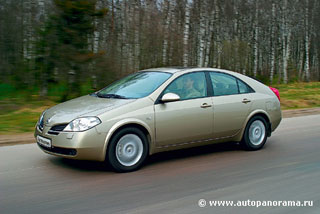 with such an appeal, it will not last long. And with a normal, even quite energetic, driving, the manual mode of the variator successfully replaces the mechanical box. In addition, there is no clutch pedal, you can slow down with your left foot, which with certain skills allows the car to be faster and smooth.
with such an appeal, it will not last long. And with a normal, even quite energetic, driving, the manual mode of the variator successfully replaces the mechanical box. In addition, there is no clutch pedal, you can slow down with your left foot, which with certain skills allows the car to be faster and smooth. Draw
So, the variator turned out to be better than mechanics and machine gun? In some ways, yes, but nevertheless there were some questions. So, according to the manufacturer, a car with a variator is slower than a machine with mechanics, and its fuel consumption is on average slightly higher. This means that so far it has not been possible to fully fully realize the advantages, which theoretically promises a stray change in the gear ratio. In addition, many more
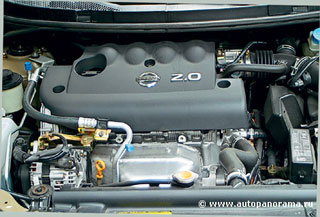 the unusual sound of the engine, which freezes during acceleration at constant speeds, will be embarrassed for a long time.
the unusual sound of the engine, which freezes during acceleration at constant speeds, will be embarrassed for a long time. Yes, and to the question about the reliability of such transmission, it will be possible to unequivocally answer in a few years, although these transmission are installed for cars with small -scale engines for a long time and there are no problems with them than with machine guns. But in general, the variator on the Nissan Primera does not look like some kind of damp exotic - this is a well -well -developed design that, in our opinion, is in no way inferior to the traditional automatic transmission, and even has an advantage over it. As for the competition with the mechanics, the price is an important factor: the manual box is simpler and cheaper, in addition, while machines with mechanics are slightly faster and consume a little less fuel. True, provided that a good driver is driving.
Some technical characteristics of the Nissan Primera 2.0 CVT
(manufacturer data)
Dimensions, mm: 4567x1760x1482
Base, mm: 2680
Track, mm: 1518
The diameter of the turn, m: 11.0
Equipped mass, kg: 1340
Trunk volume, l: 450
Engine type: gasoline in row 4-cylinder
Working volume, cubic meter. SM: 1998
Max. Power, L.S./rpm: 140/5800
Max. moment, nm/rpm: 192/4000
Transmission: Variator
Tires: 215/50 R17
Max. Speed, km/h: 191
Acceleration time 0-100 km, s: 10.9
Fuel consumption (average), l/100 km: 8.8
Top volume, l: 62
Leonid Klimanovich
A source: Avtopanorama magazine
Video Crash tests Nissan Primera sedan since 2002
Nissan Primera Sedan tests since 2002
Nissan Primera Crash Test sedan since 2002
Krassh Test: Detailed Information29%
Driver and passengers
9%
Pedestrians
Nissan Primera malfunctions since 2002
Nissan Primera Sedan malfunctions: Detailed information| Primera sedan since 2002 | |
|---|---|
| Engine |  |
| Transmission |  |
| Control system and suspension |  |
| Brake system |  |
| Air heating and air conditioning |  |
| Launch and charging system |  |
| Electric components and so on |  |
| Corrosion body stability |  |








